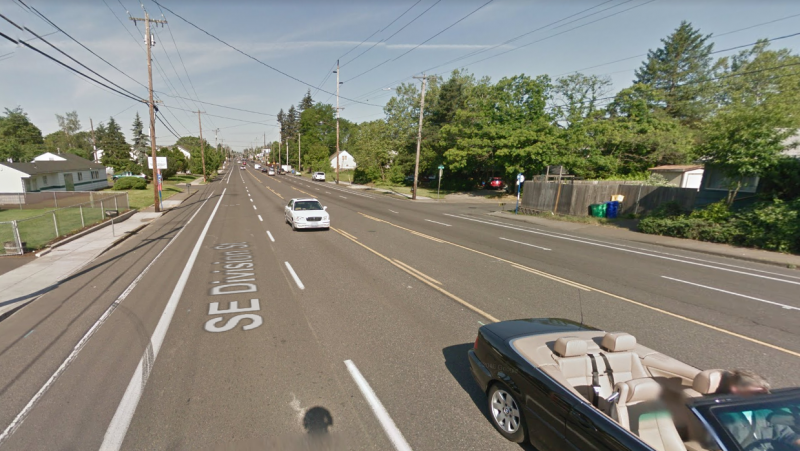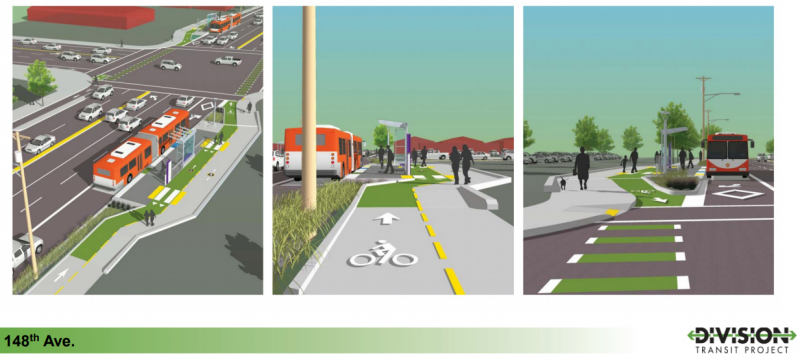(Images: TriMet)
Portland’s regional transit agency is hoping to raise $175 million for bigger, faster-moving buses on Southeast Division Street, and some major bikeway upgrades would be in store.
From SE 82nd Avenue to the Gresham city limits near 174th Avenue, the agency is planning to pay for a vertical barrier, mostly a series of concrete curbs, to protect the bike lanes that will have been recently widened and buffered by a separate City of Portland project. And when the Division bike lanes pass bus stops — as they would at 87th, I-205, 101st, 112th, 122nd, 130th, 135th, 143rd, 148th, 156th, 162nd, 168th and 174th — they’ll often be wrapping to the sidewalk side in order to reduce bike-bus conflicts.
This is a transit station design that’s in action from Seattle to Bogotá, but it’s relatively new to Portland: only a few Southwest Portland streetcar stops have used it so far.
Protected bike lanes and bus boarding islands would certainly be big improvements compared to the same stretch of Division today:

Since we last shared some images from this project in June, TriMet has nearly finished a first draft of what’s known as “30 percent design” for its project. It’s made decisions such as exactly where bus stops would go and how wide lanes and sidewalks up and down the corridor would be. In the next few weeks, it’s vetting those designs with institutions around the region, including the City of Portland’s bicycle and pedestrian advisory committees.
A few newly revealed details captured in images TriMet shared recently are worth noting. None of these were on the renderings we saw in June.
Dashed crossbikes to show bikes’ path: These are useful for helping alert people in turning cars to the possible presence of bikes, to help people confidently pedal across the street and just to raise the visibility of the bike lanes, reminding every street user that using a bike could be a good option.
Left-turn refuge boxes: One of these is easiest to spot at the top of this post, in the upper left corner of the first image. This is to help people make “Copenhagen lefts” from the bike lane, if they feel better doing so, rather than merging across multiple lanes of traffic.
Sidewalk-level uncolored bike lanes: These are more problematic. Anyone who biked or walked on Southwest Moody Avenue before 2015 knows how many people don’t notice the distinction between walking and biking lanes when they’re the same color.
Advertisement
Unprotected intersections: Both 162nd and 148th avenues have north-south bike lanes at Division. Division seems likely to become a very important east-west biking artery through Southeast Portland, and it’s possible to imagine similar protected lanes on 162nd and 148th at some point. One thing that’s not clear from these designs is why the city and TriMet haven’t chosen protected intersections that would set the bike lane crossings back from the intersection slightly. This would let people in right-turning cars make eye contact with someone on a straight-moving bike rather than prompting both parties to look over their shoulders at one another.

And here’s one thing that’s not visible:
Bike-bus priority signals: The buses pictured here are in sitting in “business access transit” lanes, basically curbside lanes that are designed for right turns and bus queue jumps. When a bus finishes loading, it would get a special traffic signal to cross the intersection first — and, TriMet project manager Michael Kiser said in an interview Tuesday, people biking and walking would get the same head start. (It’s not yet decided whether biking and walking would get a head start when a bus is not present.)
Kiser said Tuesday that though “there is buy-in in pursuing this kind of at-grade separation between bikes and peds” (in other words: a path divided into biking and walking sections), the design for how to separate biking and walking “have not been fully vetted” with the Portland Bureau of Transportation.
“We may look at a change in paving materials; maybe asphalt and concrete,” he said. “That will be informed through further discussions with PBOT.”
In general, TriMet pedestrian and bicycle planner Jeffrey Owen said Tuesday, the agency’s goal for Division is to “make it clear and delineate who’s where and when and why.”
Owen and Kiser will visit the Portland Bicycle Advisory Committee in the Lovejoy Room of City Hall, 1221 SW 4th Ave., at 6 p.m. on Oct. 17. Meetings are open to the public.
Once the agency’s current plans have been vetted and tweaked in conversation with the city and other local partners, it’ll submit them to the Federal Transit Administration in early December and hope to show up in President Trump’s budget in February, Kiser said.
(Credit for this story goes to Adam Herstein on the BikeLoudPDX listserv, a good way for ordinary Portlanders to stay up on bike advocacy opportunities in the area.)
— Michael Andersen: (503) 333-7824, @andersem on Twitter and michael@portlandafoot.org
Never miss a story. Sign-up for the daily BP Headlines email.
BikePortland needs your support.


